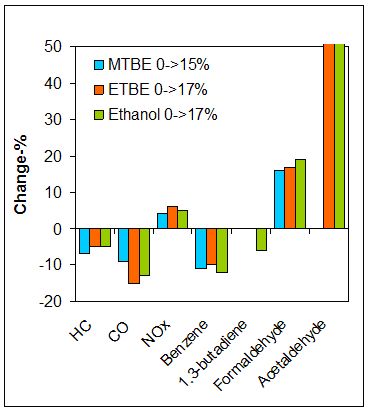Emissions
Refuelling loss evaporative emissions were not increased when vapor pressure was tailored to the same level with fuels containing 3 or 10 vol-% ethanol or 8 vol-% ETBE. Running loss emissions with ethanol tend to increase more than with gasoline, even though vapor pressures of fuels were at the same level. However, this is not the case for ETBE. Another study showed increased diurnal breathing losses with ethanol, but not with ETBE (3% ethanol or 8% ETBE blends). This was concluded to be due to differences in permeation abilities of fuels. (Wallace et al. 2009, Tanaka et al. 2006, 2007).
Arteconi et al. (2011) conducted literature review on oxygenates, including MTBE, ETBE, TAME, TAEE, and diisopropyl ether (DIPE). As concerns exhaust emissions, a number of studies referred were from 2000’s: 11 studies on MTBE, two studies on ETBE and TAEE each, and one on DIPE. Studies on TAME were from 90’s. Generally, all fuel ethers reduced harmful emissions depending on oxygenate type, blending ratio, the operating conditions, engine characteristics, and many other parameters. Some specific observations of this review are as follows:
- Fuel ethers reduced CO emissions. Highest reductions were observed for 10% MTBE blend and especially at low loads.
- MTBE and ETBE reduced HC emissions.
- MTBE and ETBE slightly increased NOx emissions (DIPE reduced NOx).
- MTBE increased formaldehyde emission.
- Regulated and unregulated emissions with TAME resemble those for MTBE. However, formaldehyde emission is higher for TAME than for MTBE.
- TAEE increased fuel consumption.
Aakko-Saksa et al. (2011) studied ETBE containing fuels with three cars at -7 °C. The major impact of ETBE was the increase in acetaldehyde emission. However, acetaldehyde emission was slightly lower with ETBE-containing fuels than with ethanol-containing fuels at the same bio-energy level. Formaldehyde emission was also higher with the ETBE-containing fuels than with gasoline, whereas 1,3-butadiene emission was lower. Contradictory results were obtained regarding benzene emission. With conventional gasoline cars, ETBE led to lower CO and HC, but higher NOx emissions, whereas an opposite trend was seen with the FFV car. ETBE seemed to reduce particulate matter associated PAHs from a direct- injection gasoline car, but not necessarily Ames mutagenicity. For gasoline cars with indirect injection technology, particulate matter emission levels were low and no significant effect of ETBE was seen. Due to isobutene emission, ETBE slightly increased ozone forming potential.
All in all, the effect of fuel ethers on the exhaust emissions in the new studies seems to follow general trends observed in 90’s. A summary of the older studies is shown in Figure 1.

Figure 1. The effect of MTBE, ETBE, and ethanol on exhaust emissions. Change-% represents difference in emissions when oxygen containing fuel is compared to non-oxygenated fuel (Aakko 2000).


